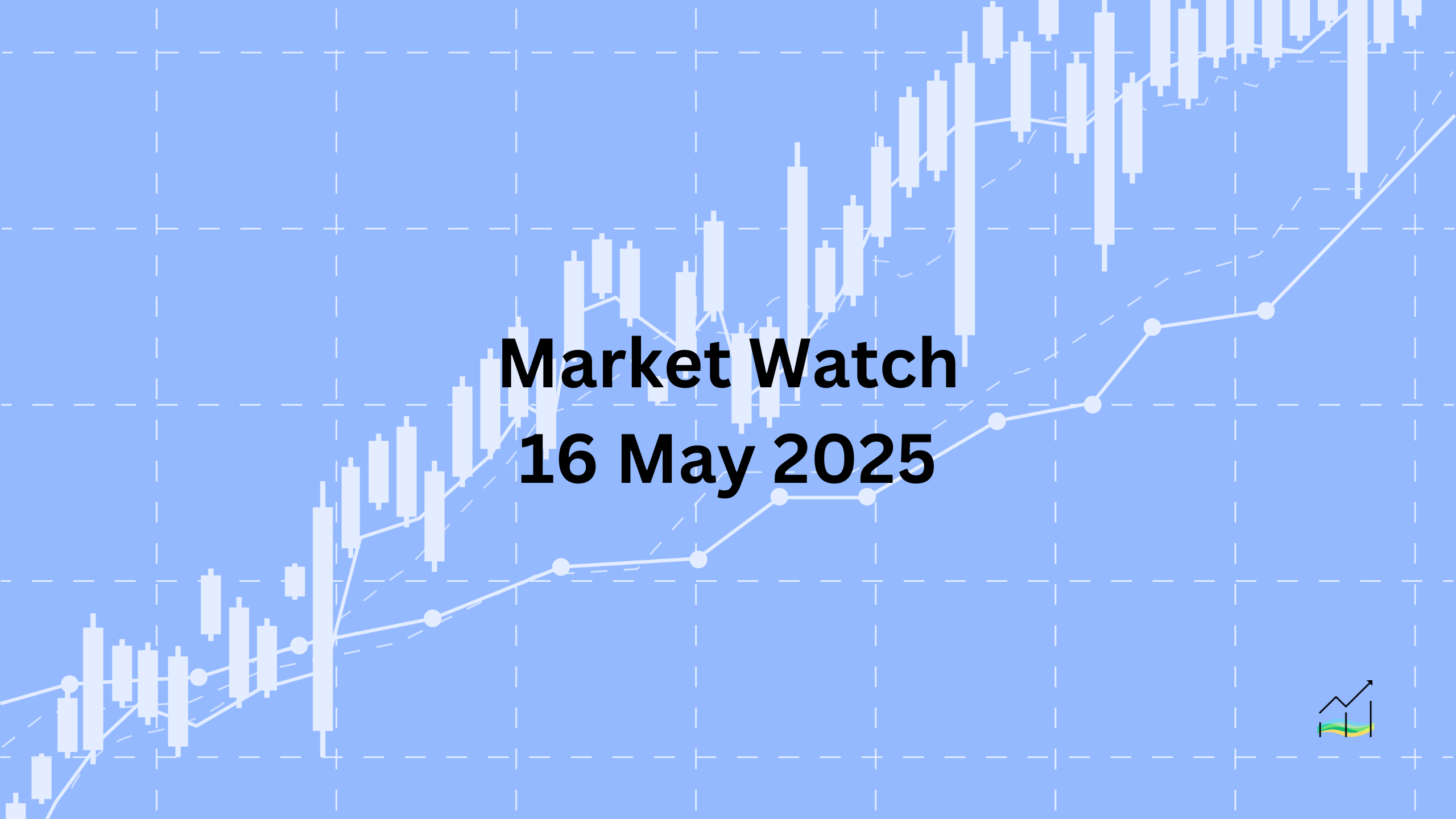16/05/2025 Market Watch

Dollar Dips, Markets Ignore Tariff Talk as Bonds & Gold Move Higher
Key Takeaways:
- US dollar softens against most G10 currencies; yen strengthens despite Japan’s Q1 GDP contraction.
- Markets largely overlook Trump’s tariff policy announcement.
- Mixed performance in Asia-Pacific stocks; European stocks rise, US futures gain modestly.
- Bond markets rally; US 10-year Treasury yield drops below 4.40%.
- Gold experiences sharp volatility, stabilizing near $3200.
- WTI crude oil maintains consolidation between $60.80–$61.80.
The US dollar displayed mild weakness today, trading softer against most major G10 currencies, though movements largely remained within Wednesday’s ranges. The Japanese yen notably strengthened, reaching fresh weekly highs despite Japan's economy reporting a contraction in the first quarter of 2025. Most emerging market currencies followed suit, gaining strength amid the broader dollar retreat. Interestingly, markets seemed unmoved by former President Trump's recent comments signaling an imminent unilateral setting of tariff rates, citing limited negotiation capacity.
Asia-Pacific equities wrapped up the trading week mixed, reflecting cautious investor sentiment across the region. In contrast, European markets demonstrated resilience, with the Stoxx 600 rising approximately 0.6%, marking its fourth consecutive daily gain. Similarly, US index futures advanced modestly, up roughly 0.25%, pointing towards a cautiously optimistic opening in North America.
Bond markets exhibited notable strength, particularly in Europe, with benchmark 10-year yields dropping around 4 to 5 basis points. The US 10-year Treasury yield followed this trend, slipping below the critical 4.40% mark. Market dynamics are currently balancing pressures from the European Central Bank’s efforts to push member banks into reducing dollar-funding dependency—which could trigger USD asset sales—and expectations of relaxed Supplemental Leverage Ratio regulations in the US, encouraging banks to hold more Treasury assets.
Gold prices showcased substantial volatility over recent sessions. After a significant rally from $3120 to a peak around $3252, sellers emerged, pushing prices back below $3200. Currently, gold trades near this psychologically important level, with market participants gauging future direction. In energy markets, July WTI crude oil futures are consolidating recent movements, trading within a relatively narrow range between $60.80 and $61.80, reflecting equilibrium between supply and demand factors for the time being.
United States of America
Overview
The US dollar remains confined to a narrow trading band, showing minimal movement for the second consecutive session as it holds within Wednesday’s established range. Despite a full economic calendar, today’s data is unlikely to have significant market impact. Key figures such as housing starts, building permits, the NY Fed services survey, and the March Treasury International Capital (TIC) report are all on deck, but none are expected to substantially influence market direction. A slight rebound in housing activity is anticipated following March’s sharp decline, while the University of Michigan’s preliminary May consumer sentiment report and inflation expectations may draw closer scrutiny.
Inflation expectations remain a point of interest, especially given the divergence between consumer survey data and market-based inflation indicators. While one-year inflation expectations stood high at 6.5% in March, market breakeven rates imply significantly lower future inflation. Softness in recent inflation prints—April CPI slightly below expectations and a drop in PPI—combined with weaker retail sales and manufacturing output, has led traders to reassess the Fed’s rate path. The probability of a rate cut in September had been declining, but recent data has revived expectations, aligning market pricing more closely with the Fed’s own outlook.
Meanwhile, concerns about capital flight have been countered by firm inflows into US assets in early 2024. TIC data reveals net inflows of approximately $338 billion during January and February, followed by nearly $98 billion in March. Although anxiety surrounding April’s capital flows has emerged, definitive data will only be available in June.
Economic Drivers
- Inflation expectations have moderated based on market breakevens, despite high consumer survey results.
- Softer inflation and weak retail sales data reignited expectations for a Fed rate cut later this year.
- Manufacturing output contracted, adding to signs of slowing economic momentum.
- Capital inflow strength persists despite market narratives of capital flight, with notable TIC data showing strong foreign investment in Q1.
Data and Events
- 16 May 2025: Housing Starts and Building Permits.
- 16 May 2025: NY Fed Services Business Activity Survey.
- 16 May 2025: March TIC Report.
- 16 May 2025: Preliminary May University of Michigan Consumer Sentiment Survey and Inflation Expectations.
Price Action
- Dollar Index remains locked in a narrow range of 100.50–100.80, still within Wednesday’s broader band of 100.25–101.15.
- Market repriced September rate cut odds higher following weaker retail sales and manufacturing output.
- Treasuries reflected inflation relief and growth concerns, narrowing breakeven spreads.
Key Points:
- Dollar is range-bound amid data-heavy session with limited market impact expected.
- Consumer sentiment and inflation expectations likely to draw more attention than housing or services data.
- Markets lean toward aligning with Fed's rate cut guidance after softer recent data.
- Strong foreign capital inflows counter recent fears of US capital flight.
China
Overview
The Chinese yuan has seen only limited movement following the dollar’s rebound from its lowest level of the year. The greenback's upward momentum has stalled near CNH7.2160, remaining confined to Wednesday’s range. Meanwhile, the People’s Bank of China (PBOC) continued to guide the yuan stronger, setting the daily reference rate lower for the fourth consecutive session. This suggests deliberate efforts to support the currency amid ongoing trade and geopolitical developments.
China appears to have emerged in a favourable position from the most recent trade talks with the United States. Washington agreed to suspend newly imposed reciprocal tariffs for a 90-day period—one of Beijing’s conditions for engaging in the negotiations. While this temporary reprieve excludes sectoral, de minimis, and port-related tariffs, it has triggered a surge in Chinese exports to the US as firms rush to capitalise on the window, driving up container shipping costs. Despite these reduced tariffs, major US retailers like Walmart have already signalled impending price hikes.
Beyond US-China bilateral developments, geopolitical tensions continue to simmer. The US has ramped up pressure on other countries to restrict Huawei chip exports. India, feeling strengthened by China's posture, has threatened retaliatory action in response to US steel and aluminium tariffs, which it argues are protective measures disguised as national security. At the same time, US officials hint that a trade deal with India may be close.
Elsewhere, China's influence in Latin America continues to deepen. Brazil and China signed approximately 30 new sectoral and investment agreements this week. Additionally, Colombia is reported to have signed a memorandum of understanding with China on the Belt and Road Initiative (BRI), joining a growing list of regional participants including Venezuela, Ecuador, Chile, Peru, Bolivia, and Panama.
Economic Drivers
- PBOC guided the yuan higher by lowering the daily reference rate four consecutive times.
- China secured a favourable outcome in trade talks with the US, gaining a 90-day suspension of reciprocal tariffs.
- Surge in export shipments to the US has led to increased container shipping costs.
- Walmart indicated prices would still rise, despite tariff relief.
- US is pressuring global allies to block Huawei chip shipments, extending its tech restrictions.
- India, emboldened by China’s trade positioning, threatens retaliation over US steel and aluminium tariffs.
- China deepens economic ties with Latin America through new investment and BRI agreements.
Data and Events
No major economic releases are scheduled today.
Price Action
- Dollar remains capped near CNH7.2160, holding within a tight range set earlier this week.
- Yuan reference rate fixed lower again at CNY7.1938, compared to CNY7.1963 the day before.
- PBOC’s consistent action signals controlled appreciation bias amid geopolitical noise.
Key Points:
- PBOC continues guiding yuan stronger through daily fixings.
- China benefited from latest US trade negotiations with temporary tariff relief.
- Exporters rushing to take advantage of 90-day window are pushing up shipping costs.
- China expands influence in Latin America through BRI and bilateral agreements.
Japan
Overview
The Japanese yen has strengthened notably this week, pulling the dollar lower from its Monday high of JPY148.65 to below JPY145.00—its lowest level since early April. This four-day decline in USD/JPY represents a 38.2% retracement of the broader rally from the eight-month low of JPY139.90 recorded on April 22. A larger retracement level sits around JPY144.25. Interestingly, this rebound in the yen comes despite underwhelming macroeconomic data, suggesting market participants may be repricing expectations due to other factors, including speculative positioning and lower expectations for domestic tightening.
Japan’s preliminary Q1 GDP figures showed a 0.2% contraction, following a 0.6% expansion in Q4 2024. Consumer spending remained stagnant, while business investment expanded more than expected, rising 1.4% after an upwardly revised Q4 figure. Inventory restocking also supported growth, reversing its negative contribution from the previous quarter. However, net exports were a significant drag, subtracting 0.8% from GDP after contributing positively in Q4.
Despite the disappointing headline GDP number, there was a positive revision in March’s industrial production data, now showing a modest increase rather than a sharp decline. Meanwhile, the swaps market has pared back expectations for policy tightening this year, with around 16 basis points of hikes priced in—slightly below recent peaks.
Economic Drivers
- Japan’s economy contracted by 0.2% in Q1 2025, ending a modest growth streak.
- Consumption remained flat, offering no support to GDP growth.
- Business investment continued to rise, suggesting ongoing private sector confidence.
- Inventories made a positive contribution to GDP, offsetting previous declines.
- Net exports subtracted significantly from growth, reversing prior gains.
- Industrial production in March was revised upward from -1.1% to +0.2%.
- Market expectations for further tightening have slightly declined, with only 16 basis points priced in.
Data and Events
- 16 May 2025: Final Industrial Production (March, revised).
- 16 May 2025: Japan Q1 GDP (Preliminary)
Price Action
- USD/JPY reversed from a high of JPY148.65 to a low just under JPY145.00.
- The four-day slide marks a 38.2% retracement of gains since April 22’s low.
- Key technical level to watch is JPY144.25, the 50% retracement mark.
- $735 million in options expiring today may add short-term volatility.
Key Points:
- Yen strengthens despite weak Q1 GDP, driven by broader market dynamics.
- GDP shows contraction with weak consumption but strong business spending.
- Net exports a major drag on growth.
- Revised industrial data softens the blow, but policy tightening expectations have cooled.
United Kingdom
Overview
Sterling remains in a consolidation phase, trading within Wednesday’s range of approximately $1.3255 to $1.3360. This sideways movement reflects a wait-and-see attitude in the market despite stronger-than-expected economic data. The pound's recent performance has not yet triggered a decisive breakout, with traders assessing whether the next directional move will retest higher resistance levels near $1.3400–$1.3445 or retreat towards the $1.3140 zone.
The latest GDP data provided an unexpected lift. The first estimate of Q1 growth came in at 0.7%, surpassing expectations and marking the strongest quarterly performance since Q1 2024. That said, the momentum may have faded toward the end of the quarter, and market focus is now shifting to upcoming Q2 data. April’s inflation and retail sales figures, alongside the preliminary May PMIs, will offer insight into whether the UK economy can maintain its recent strength.
From a monetary policy standpoint, the swaps market currently places a low probability on consecutive rate cuts. The likelihood of a rate cut at the next policy meeting is seen as very slim, while expectations for an August cut have been revised down to around 72%, down sharply from nearly 97% just a week earlier.
Economic Drivers
- Q1 2025 GDP rose 0.7%, the strongest reading since Q1 2024.
- Growth momentum may have weakened by the end of the quarter.
- Markets are focused on upcoming inflation, retail, and PMI data to gauge Q2 resilience.
- Probability of back-to-back rate cuts has fallen, with markets ruling out a June cut.
- August rate cut odds have dropped from 97% to about 72%.
Data and Events
No major economic releases are scheduled today.
Price Action
- GBP/USD remains trapped in a tight range (~$1.3255–$1.3360).
- Upside breakout could open path toward $1.3400–$1.3445.
- Downside break below $1.3225–$1.3250 risks a drop toward $1.3140.
Key Points:
- Sterling consolidates despite strong GDP data.
- Q1 growth surprised to the upside but may not carry through into Q2.
- Market sees minimal risk of a rate cut in June; August odds have eased.
- Upcoming CPI, retail sales, and PMI data are crucial for forward guidance.
© 2025 SKONE Enterprise (003319453-V). All rights reserved.
The content on this site is for informational purposes only and does not constitute financial advice.


